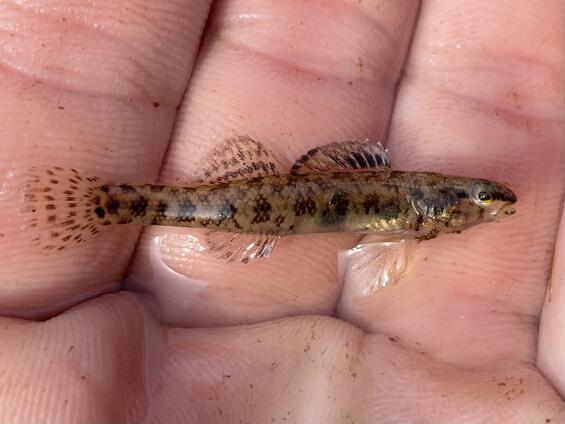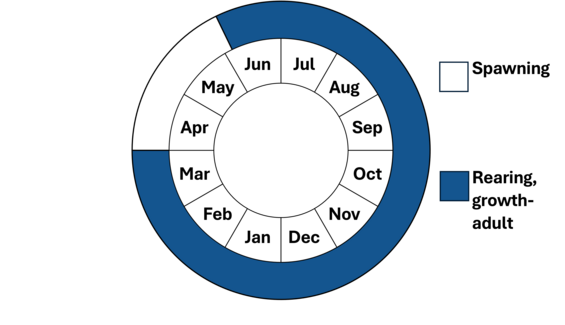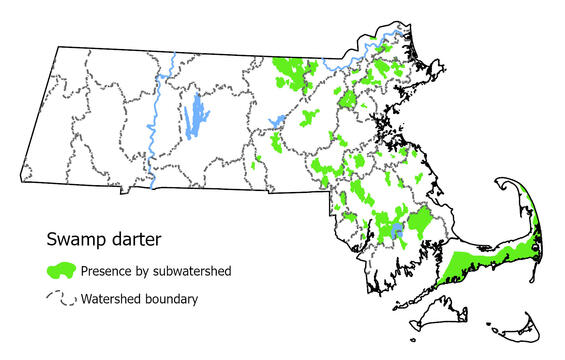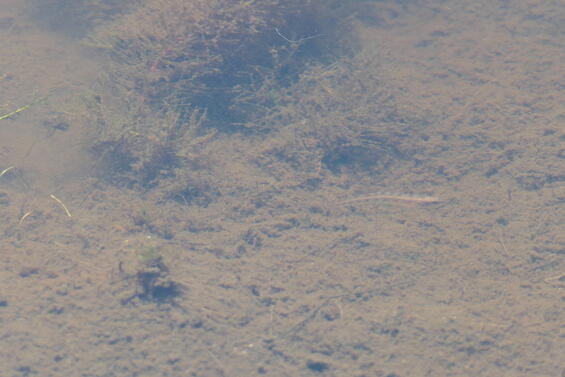- Scientific name: Etheostoma fusiforme
- Species of Greatest Conservation Need (MA State Wildlife Action Plan)
Description

Swamp Darter (Etheostoma fusiforme)
The swamp darter has an incomplete lateral line that curves upward within three scales of the first dorsal fin and possesses two anal spines. The body is brownish tan with about 10 dark-brown blotches that often merge into a continuous band along the mid-side, and a small spot at the base of the tail. Overall coloration varies; fish from weedy and tannic waters are quite dark, while those from sandy-bottomed, clear ponds are somewhat lighter in color. Adults range from 1 to 2 inches. Swamp darters often rest on aquatic vegetation and dart out to capture small aquatic organisms. Copepods are their most common prey.
Life cycle and behavior

Swamp darters spawn between April and May. Spawning occurs among aquatic vegetation where eggs are deposited. Eggs hatch in 8-10 days.
Population status
The population status of swamp darters has not been fully assessed, although they are relatively common in coastal rivers and watersheds where they are known to occur.
Distribution and abundance
In Massachusetts, swamp darters are found in all major drainages in the eastern part of the state, on Cape Cod, Nantucket, and Martha's Vineyard. Swamp darters are still common in many areas of eastern Massachusetts. However, their overall distribution has been reduced due to the development of the large eastern cities and towns. While their range in Massachusetts is limited to the eastern part of the state, they are common in coastal areas from New England to as far south as Florida, as well as the Gulf States in the lower Mississippi Basin.

Data from 1999-2024 from annual surveys.
Habitat
Swamp darters typically inhabit still or slow-flowing water where vegetation is abundant over mud and detritus bottoms. On Cape Cod and the Islands, however, they are found in clear water ponds with only moderate vegetation.
Healthy habitats are vital for supporting native wildlife and plants. Explore habitats and learn about conservation and restoration in Massachusetts.

Ideal swamp darter habitat.
Threats
Pollution or other alterations to its habitats appear to be the major potential threats to this species.
Conservation
The protection and restoration of coastal and low-gradient river and stream habitats would likely be beneficial to the conservation of swamp darters.
Surveying and monitoring
Swamp darters are regularly collected during standard river and stream surveys, where their length and abundance are monitored.
Management
Currently no management plans exist for swamp darters.
Research needs
A better understanding of habitat requirements (physical and chemical) may aid in conservation and management efforts concerning swamp darters.
References
This species description was adapted, with permission, from: Karsten E. Hartel, David B. Halliwell, and Alan E. Launer.
2002. Inland Fishes of Massachusetts. Massachusetts Audubon Society, Lincoln, Massachusetts.
Contact
| Date published: | April 10, 2025 |
|---|